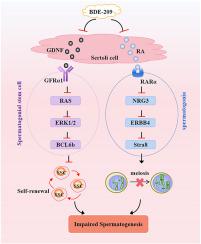当前位置:
X-MOL 学术
›
Environ. Pollut.
›
论文详情
Our official English website, www.x-mol.net, welcomes your feedback! (Note: you will need to create a separate account there.)
The role of Sertoli cells-secreted factors in different stages of germ cells development in mice exposed to BDE-209
Environmental Pollution ( IF 8.9 ) Pub Date : 2024-03-17 , DOI: 10.1016/j.envpol.2024.123775 Yue Zhang , Xiangyang Li , Leqiang Gao , Xiaomin Dong , Jinglong Xue , Moxuan Zhao , Junhong Xie , Aliekram Niyaz , Lihua Ren , Xianqing Zhou
Environmental Pollution ( IF 8.9 ) Pub Date : 2024-03-17 , DOI: 10.1016/j.envpol.2024.123775 Yue Zhang , Xiangyang Li , Leqiang Gao , Xiaomin Dong , Jinglong Xue , Moxuan Zhao , Junhong Xie , Aliekram Niyaz , Lihua Ren , Xianqing Zhou

|
Decabromodiphenyl ether (BDE-209), a frequently used brominated flame retardant, readily enters the environment and is difficult to degrade with bioaccumulation. BDE-209 could cause male reproductive toxicity, but the regulatory functions of Sertoli cells-secreted factors remain uncertain. In present study, male mice were treated with 75 mg/kg BDE-209 and then stopped exposure for 50 days. Exogenous Glial cell line-derived neurotrophic factor (GDNF), a Sertoli cell-secreted factor, was injected into testes of mice treated with BDE-209 for 50 days to explore the role of GDNF in BDE-209-induced reproductive toxicity. The mouse spermatogonia cell line GC-1 spg was used to further verify regulatory effects of Sertoli cells-secreted factors on meiotic initiation. The results showed that BDE-209 inhibited expressions of the self-renewal pathway GFRα-1/RAS/ERK1/2 in spermatogonial stem cells (SSCs), and reduced expressions of spermatogonia proliferation-related pathway NRG3/ERBB4 and meiosis initiation factor Stra8. Furthermore, BDE-209 decreased the levels of both GDNF and retinoic acid (RA) secreted by Sertoli cells in testes. Importantly, the alterations of above indicators induced by BDE-209 did not recover after 50-day recovery period. After exogenous GDNF injection, the decreased expression of GFRα-1/RAS/ERK in SSCs was reversed. However, the level of RA and expressions of NRG3/ERBB4/Stra8 were not restored. The experimental results showed that exogenous RA reversed the reductions in NRG3/ERBB4/Stra8 and ameliorated inhibition of GC-1 spg cells proliferation induced by BDE-209. These results suggested that Sertoli cells-secreted factors play roles in regulating various stages of germ cell development. Specifically, BDE-209 affected the self-renewal of SSCs by decreasing GDNF secretion resulting in the inhibition of GFRα-1/RAS/ERK pathway; BDE-209 hindered the proliferation of spermatogonia and initiation of meiosis by inhibiting the secretion of RA and preventing RA from binding to RARα, resulting in the suppression of NRG3/ERBB4/Stra8 pathway. As a consequence, spermatogenesis was compromised, leading to persistent male reproductive toxicity.
中文翻译:

支持细胞分泌因子在接触 BDE-209 的小鼠生殖细胞发育不同阶段中的作用
十溴二苯醚 (BDE-209) 是一种常用的溴化阻燃剂,很容易进入环境,并且难以通过生物蓄积降解。 BDE-209可能引起男性生殖毒性,但支持细胞分泌因子的调节功能仍不确定。在本研究中,雄性小鼠接受 75 mg/kg BDE-209 治疗,然后停止暴露 50 天。将外源性胶质细胞源性神经营养因子(GDNF)(一种支持细胞分泌的因子)注射到用 BDE-209 治疗 50 天的小鼠睾丸中,以探讨 GDNF 在 BDE-209 诱导的生殖毒性中的作用。利用小鼠精原细胞系GC-1 spg进一步验证支持细胞分泌因子对减数分裂起始的调节作用。结果表明,BDE-209抑制精原干细胞(SSC)中自我更新途径GFRα-1/RAS/ERK1/2的表达,并减少精原细胞增殖相关途径NRG3/ERBB4和减数分裂起始因子Stra8的表达。此外,BDE-209 降低了睾丸支持细胞分泌的 GDNF 和视黄酸 (RA) 的水平。重要的是,BDE-209引起的上述指标的改变在50天的恢复期后并未恢复。注射外源性GDNF后,SSCs中GFRα-1/RAS/ERK表达的降低被逆转。然而,RA水平和NRG3/ERBB4/Stra8的表达并未恢复。实验结果表明,外源性RA逆转了NRG3/ERBB4/Stra8的减少,并改善了BDE-209诱导的GC-1 spg细胞增殖的抑制。这些结果表明支持细胞分泌因子在调节生殖细胞发育的各个阶段中发挥作用。具体来说,BDE-209通过减少GDNF分泌来影响SSC的自我更新,从而抑制GFRα-1/RAS/ERK通路; BDE-209通过抑制RA的分泌并阻止RA与RARα结合,从而抑制NRG3/ERBB4/Stra8通路,从而阻碍精原细胞的增殖和减数分裂的启动。结果,精子发生受到损害,导致持续的男性生殖毒性。
更新日期:2024-03-17
中文翻译:

支持细胞分泌因子在接触 BDE-209 的小鼠生殖细胞发育不同阶段中的作用
十溴二苯醚 (BDE-209) 是一种常用的溴化阻燃剂,很容易进入环境,并且难以通过生物蓄积降解。 BDE-209可能引起男性生殖毒性,但支持细胞分泌因子的调节功能仍不确定。在本研究中,雄性小鼠接受 75 mg/kg BDE-209 治疗,然后停止暴露 50 天。将外源性胶质细胞源性神经营养因子(GDNF)(一种支持细胞分泌的因子)注射到用 BDE-209 治疗 50 天的小鼠睾丸中,以探讨 GDNF 在 BDE-209 诱导的生殖毒性中的作用。利用小鼠精原细胞系GC-1 spg进一步验证支持细胞分泌因子对减数分裂起始的调节作用。结果表明,BDE-209抑制精原干细胞(SSC)中自我更新途径GFRα-1/RAS/ERK1/2的表达,并减少精原细胞增殖相关途径NRG3/ERBB4和减数分裂起始因子Stra8的表达。此外,BDE-209 降低了睾丸支持细胞分泌的 GDNF 和视黄酸 (RA) 的水平。重要的是,BDE-209引起的上述指标的改变在50天的恢复期后并未恢复。注射外源性GDNF后,SSCs中GFRα-1/RAS/ERK表达的降低被逆转。然而,RA水平和NRG3/ERBB4/Stra8的表达并未恢复。实验结果表明,外源性RA逆转了NRG3/ERBB4/Stra8的减少,并改善了BDE-209诱导的GC-1 spg细胞增殖的抑制。这些结果表明支持细胞分泌因子在调节生殖细胞发育的各个阶段中发挥作用。具体来说,BDE-209通过减少GDNF分泌来影响SSC的自我更新,从而抑制GFRα-1/RAS/ERK通路; BDE-209通过抑制RA的分泌并阻止RA与RARα结合,从而抑制NRG3/ERBB4/Stra8通路,从而阻碍精原细胞的增殖和减数分裂的启动。结果,精子发生受到损害,导致持续的男性生殖毒性。



























 京公网安备 11010802027423号
京公网安备 11010802027423号